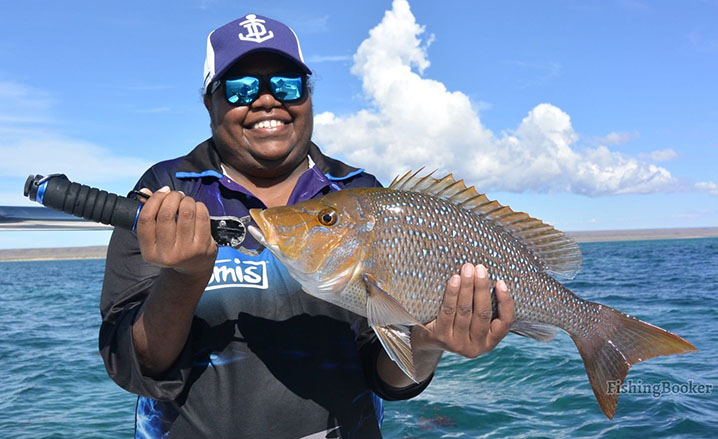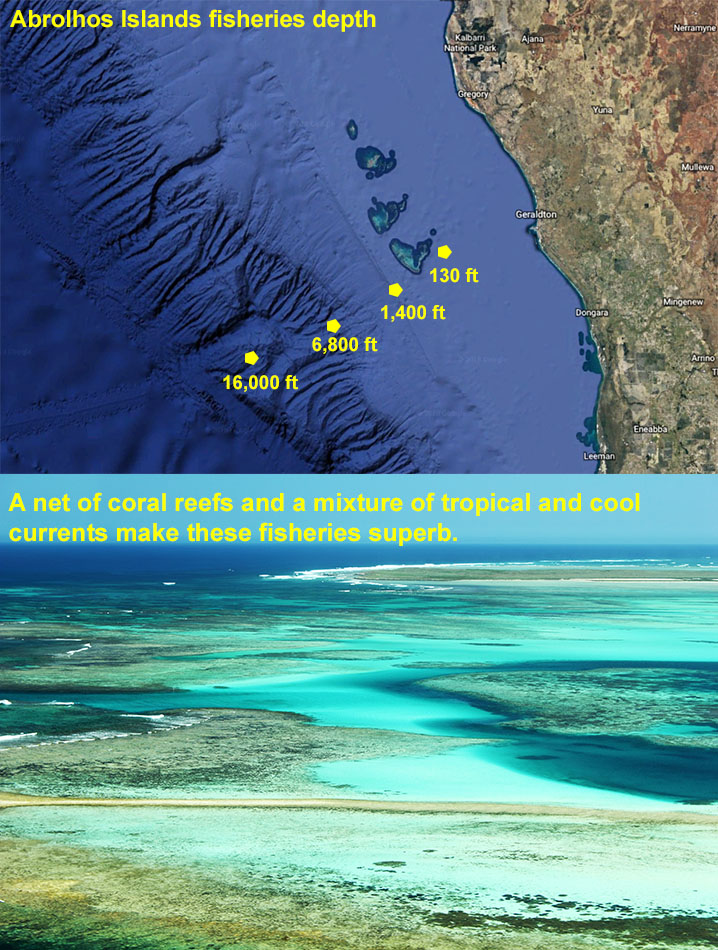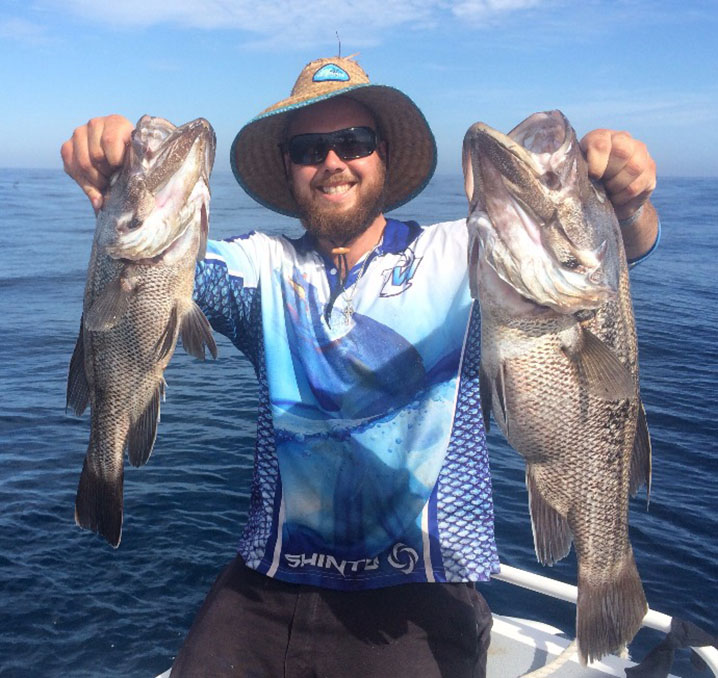Australian waters have long been known for harboring some of the best fishing spots in the world. From catching Black Marlin near the Great Barrier Reef to fishing for Barramundi in creeks and rivers near Darwin, these fisheries will leave you spoiled for choice. But there is one tiny place in Western Australia where the action is unlike any other. Today, we’re going to explore the Abrolhos Islands fishing, learn about the local fish species, and talk about the techniques to catch them.

The Abrolhos is a chain of some 120 islands in the Indian Ocean, about 50 miles off the coast of Western Australia. These coral reefs serve as a major shelter for breeding seabirds and are also the main fishing spot for western rock lobster. These tiny but delicious critters make up a fifth of Australia’s fishing industry.
But anglers have found Abrolhos’ appeal to be elsewhere: this chain of sandy islands, where winds are always strong, lies at a meeting point of cool and tropical currents. A cool current comes from the south, while the tropical waters of the ocean flow in from the north. This creates a real bait fish buffet, where game fish come to feast.
Coming to the Abrolhos is for real fishing lovers only. These islands offer no accommodation. It’s dry land with shrubbery, weeds, and mangroves. They serve as home to numerous bird species, and even more fish! To come here, you’ll need to board a vessel in Geraldton and travel west. However, gale-like headwinds can put a lag on your trip, so you could spend more than two hours just reaching the fishing grounds.
The fisheries of the Abrolhos
The 122 islands of the Abrolhos are divided into three major groups of islands: the Wallabi Group, the Easter Group, and the Pelsaert Group. On average, these groups stretch across a surface of 12 by 9 miles along the edge of Australia’s continental shelf. The depth of the shelf is some 150+ ft and it’s relatively level.
As you travel west, the ocean floor will gradually start descending, at about 7 ft per mile. Then some 3 miles to the west of Abrolhos, where the shelf break lies, the ocean floor will start a more noticeable plunge, dropping about 260 ft with each passing mile. The fisheries within each island group are mostly shallow, but as you make your way towards other island groups, you’ll be wetting your line in waters that are 150 ft deep.

We’ve touched upon this already, but we should emphasize it once more – there’s some serious wind going on here most of the time. It may not be as strong as it is on the mainland, but it sure is persistent. You can expect 18 knot winds from the south during the summer months. As the high-pressure ridge moves north in cooler months of the year, the islands themselves will endure stronger but variable winds. But it doesn’t end there.
Due to temperature differences between the ocean and the dry land, there is a series of land breezes that blow in the morning, while in the afternoons you can expect south-west sea breezes.
The morning bite and relentless wind
Most anglers who make the effort to come to the Abrolhos come for a multi-day charter. That will give you some time to enjoy the view, adjust to the conditions, and get that fish. The key here is to be flexible.
The morning bite will be a challenge, as the combination of seawind and land breeze can make some of the best spots unfishable. Even the inshore waters, which are only a couple of dozen feet deep can quickly become too choppy. Then it’s best to find sheltered areas with clear shallows, where the waters are about 20–50 ft deep. This will let you recover from the wind and cast your bait for some of the tried-and-tested tasty fish.
Pink Snapper, Spangled Emperor, and Coral Trout
Pink Snapper, Emperor, and Coral Trout are a common sight around here. They may not be your exact idea of a serious fight worth the effort, but believe us – these fish are feisty. Pink Snapper can reach several pounds and will gnaw at your soft plastics with no relent. Spangled Emperor have sharp teeth and fight hard. Some of them reach 15 pounds! One thing to remember about Spangled Emperors is that they can change their scales’ color pattern within minutes, especially if they are scared. So, even though there is wind, fishing for these bottom feeders is a fun way to start your day – and prepare for some tougher fighters down below.

Baldchin Groper: One Special Fish
Speaking of which, there is one fish in these waters that everyone wants to catch: Baldchin Groper. These fish are endemic to the fisheries of Western Australia and are most abundant near the Abrolhos Islands. Members of the Wrasse family, they live near the seabed and keep close to the shore. You can find them in waters between 60 and 160 ft, hiding between corals and rocks. Anglers praise them for their white flaky meat and their cunning tactics. They will first deal a blow to your soft plastics, then make for cover around the maze of corals. If you don’t act fast, you’ll use your line in no time.

Narrow-barred Mackerel
As you move to more open waters you’ll able to do some trolling for Narrow-barred Mackerel. These Kingfish cousins make a lot of fuss when hooked, and won’t give in that easily. They are harder on the hook, but softer on the palate! Plus, they can weigh between 30 and 80 pounds, but most of the fish you’ll hook into around the Abrolhos weigh about 40 pounds. You can troll for them using bibble minnows. One thing to have in mind: down under, Narrow-barred Mackerel are called Spanish Mackerel.

Westralian Dhufish: Another Jew(el) in the Abrolhos Crown
The ultimate beauty in the diverse offer of the Abrolhos fisheries is West Australian Dhufish. These fish are the rockstars of the show: they can grow to over 50 pounds, but you’ll mostly find them to be about 20 pounds.

They taste like heaven, look glamorous (just look at their black scales) and fight dirty. You will find them inshore, lurking near the seabed in waters that rarely exceed 150 ft. Once hooked, they run for shelter, pulling your line around the corals. This means you’ll most likely need to stock up on some more line soon.
Dhufish are endemic to these waters and are therefore managed strictly. You can keep only one fish per angler per day, or two per boat if you’re fishing from your own vessel.
A True Westralian Goody Bag
If you think that’s all the Abrolhos has to offer, you’re plain wrong. These fisheries are so rich that you could be coming back year after year and still not exhaust the list.

Abrolhos’ biggest draw is also its biggest advantage: if you keep your cool and accept that it’s going to be windy, you could benefit a lot from the confluence of tropical and cool currents. They are the reason that you can catch so many species here, including – but not limited to! – Samson Fish, Yellowtail Kingfish, numerous species of Trevally, Red Emperor, as well as some serious game fish, such as Blue, Black, and Striped Marlin, Wahoo, Yellowfin Tuna, and Sailfish.
If you crave more information on how to fish in Australia, take a look at our Australia fishing guide and learn about fish species, hotspots, angling techniques, and regulations.
So, let’s hear your experience. Have you been to the Abrolhos before? What fish did you catch there? Are you planning on visiting these fisheries any time soon? Let us know in the comments below!
